Analysis of Motivational Theories and Organisational Behaviour
VerifiedAdded on 2020/10/23
|17
|5601
|325
AI Summary
The assignment analyses the role of motivational theories in organisations, including Maslow's hierarchy, content theory, and Vroom's expectancy theory. It examines how these theories can influence employee motivation and performance, and discusses the importance of organisational culture and behaviour in promoting a positive work environment.
Contribute Materials
Your contribution can guide someone’s learning journey. Share your
documents today.
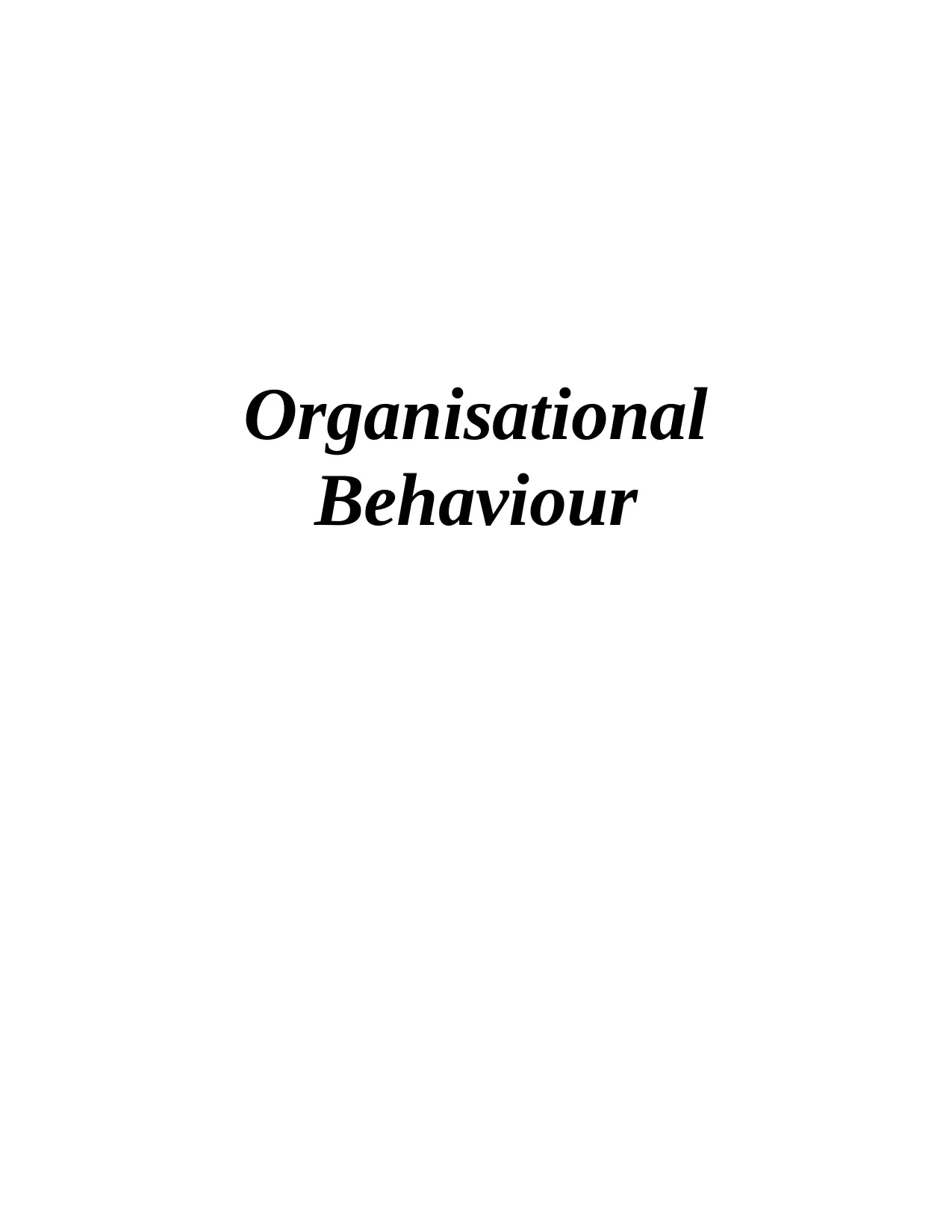
Organisational
Behaviour
Behaviour
Secure Best Marks with AI Grader
Need help grading? Try our AI Grader for instant feedback on your assignments.

Table of Contents
INTRODUCTION...........................................................................................................................1
TASK 1............................................................................................................................................1
P1: Influence of organisation's politics, culture and power on team and individual
performance.................................................................................................................................1
M1 Critically analyse how the culture, politics and power of 4com PLC influence individual
and team behaviour and performance.........................................................................................5
TASK 2............................................................................................................................................5
P2: Motivational theories for achieving organisational goals.....................................................5
M2 Critically evaluate how to influence the behaviour of others with proper application of
behavioural motivational theories, concepts and models............................................................8
D1 Critically evaluate the relationship between culture, politics, power and motivation that
enables teams and organisations to succeed providing justified recommendations....................8
TASK 3............................................................................................................................................8
P3: State what makes a team more effective as opposed to an ineffective team........................8
M3 Analyse relevant team and group development theories to support the development of
dynamic cooperation.................................................................................................................11
TASK 4..........................................................................................................................................11
P4: Philosophies and concepts of organisational behaviour.....................................................11
M4 Explore and evaluate how concepts and philosophies of OB inform and influence
behaviour in both a positive and negative way.........................................................................12
D2 Critically analyse and evaluate the relevance of team development theories in context of
organisational behaviour concepts and philosophies that influence behaviour........................13
CONCLUSION..............................................................................................................................13
REFERENCES..............................................................................................................................14
INTRODUCTION...........................................................................................................................1
TASK 1............................................................................................................................................1
P1: Influence of organisation's politics, culture and power on team and individual
performance.................................................................................................................................1
M1 Critically analyse how the culture, politics and power of 4com PLC influence individual
and team behaviour and performance.........................................................................................5
TASK 2............................................................................................................................................5
P2: Motivational theories for achieving organisational goals.....................................................5
M2 Critically evaluate how to influence the behaviour of others with proper application of
behavioural motivational theories, concepts and models............................................................8
D1 Critically evaluate the relationship between culture, politics, power and motivation that
enables teams and organisations to succeed providing justified recommendations....................8
TASK 3............................................................................................................................................8
P3: State what makes a team more effective as opposed to an ineffective team........................8
M3 Analyse relevant team and group development theories to support the development of
dynamic cooperation.................................................................................................................11
TASK 4..........................................................................................................................................11
P4: Philosophies and concepts of organisational behaviour.....................................................11
M4 Explore and evaluate how concepts and philosophies of OB inform and influence
behaviour in both a positive and negative way.........................................................................12
D2 Critically analyse and evaluate the relevance of team development theories in context of
organisational behaviour concepts and philosophies that influence behaviour........................13
CONCLUSION..............................................................................................................................13
REFERENCES..............................................................................................................................14


INTRODUCTION
Organisation behaviour is related with examination of attitude and working behaviour of
employees as an individual and as a team member at workplace. Employees are considered as a
valuable asset of company whose maximum contribution assist organisations to accomplish its
craved goals and aims in pre-determined time. Therefore, the management is held liable to
maximise the working behaviour of employees through identifying and fulfilling their needs and
requirements at workplace which can be done either through giving them rewards, promotion,
incentives etc. or through conducting training and development programs. The present
assignment report is based in 1spatial Plc which is operated its business functions through three
segments such as Geospatial, cloud service and Central costs. It is established in 2005 and has
attained 170 employees. The project includes the impact of power, politics and culture on
performance of teams and individuals that can affect the performance of an organisation. The
project also mentions various motivational theories, concepts and philosophies of OB,
importance of team to an organisation along with the differentiation between effective and
ineffective team.
TASK 1
P1:
At present, organisation's politics issues, culture and power are such viable and vital
elements which can influence the execution level of an organisation both in negative or positive
way. Power alludes to an authority allocated to a person to exercise and impact working conduct
of employees and accordingly get complete work from them in a viable and proficient way
(Chiboiwa, Chipunza and Samuel, 2011).
Impacts of Power on individual and groups:
Positive power exercised by managers in favour of staff members in form of giving them
appropriate direction and inspiration to perform well with a hope of getting maximum gainful
outcome which support their professional growth as well as overall performance level of an
organisation. Such power assigned to managers performs crucial roles such as allocation of roles
and duties, giving prizes and valuation for work, acknowledgement of efforts and so forth to
their staff members. These roles and responsibilities are performed for the improvement and
1
Organisation behaviour is related with examination of attitude and working behaviour of
employees as an individual and as a team member at workplace. Employees are considered as a
valuable asset of company whose maximum contribution assist organisations to accomplish its
craved goals and aims in pre-determined time. Therefore, the management is held liable to
maximise the working behaviour of employees through identifying and fulfilling their needs and
requirements at workplace which can be done either through giving them rewards, promotion,
incentives etc. or through conducting training and development programs. The present
assignment report is based in 1spatial Plc which is operated its business functions through three
segments such as Geospatial, cloud service and Central costs. It is established in 2005 and has
attained 170 employees. The project includes the impact of power, politics and culture on
performance of teams and individuals that can affect the performance of an organisation. The
project also mentions various motivational theories, concepts and philosophies of OB,
importance of team to an organisation along with the differentiation between effective and
ineffective team.
TASK 1
P1:
At present, organisation's politics issues, culture and power are such viable and vital
elements which can influence the execution level of an organisation both in negative or positive
way. Power alludes to an authority allocated to a person to exercise and impact working conduct
of employees and accordingly get complete work from them in a viable and proficient way
(Chiboiwa, Chipunza and Samuel, 2011).
Impacts of Power on individual and groups:
Positive power exercised by managers in favour of staff members in form of giving them
appropriate direction and inspiration to perform well with a hope of getting maximum gainful
outcome which support their professional growth as well as overall performance level of an
organisation. Such power assigned to managers performs crucial roles such as allocation of roles
and duties, giving prizes and valuation for work, acknowledgement of efforts and so forth to
their staff members. These roles and responsibilities are performed for the improvement and
1
Secure Best Marks with AI Grader
Need help grading? Try our AI Grader for instant feedback on your assignments.
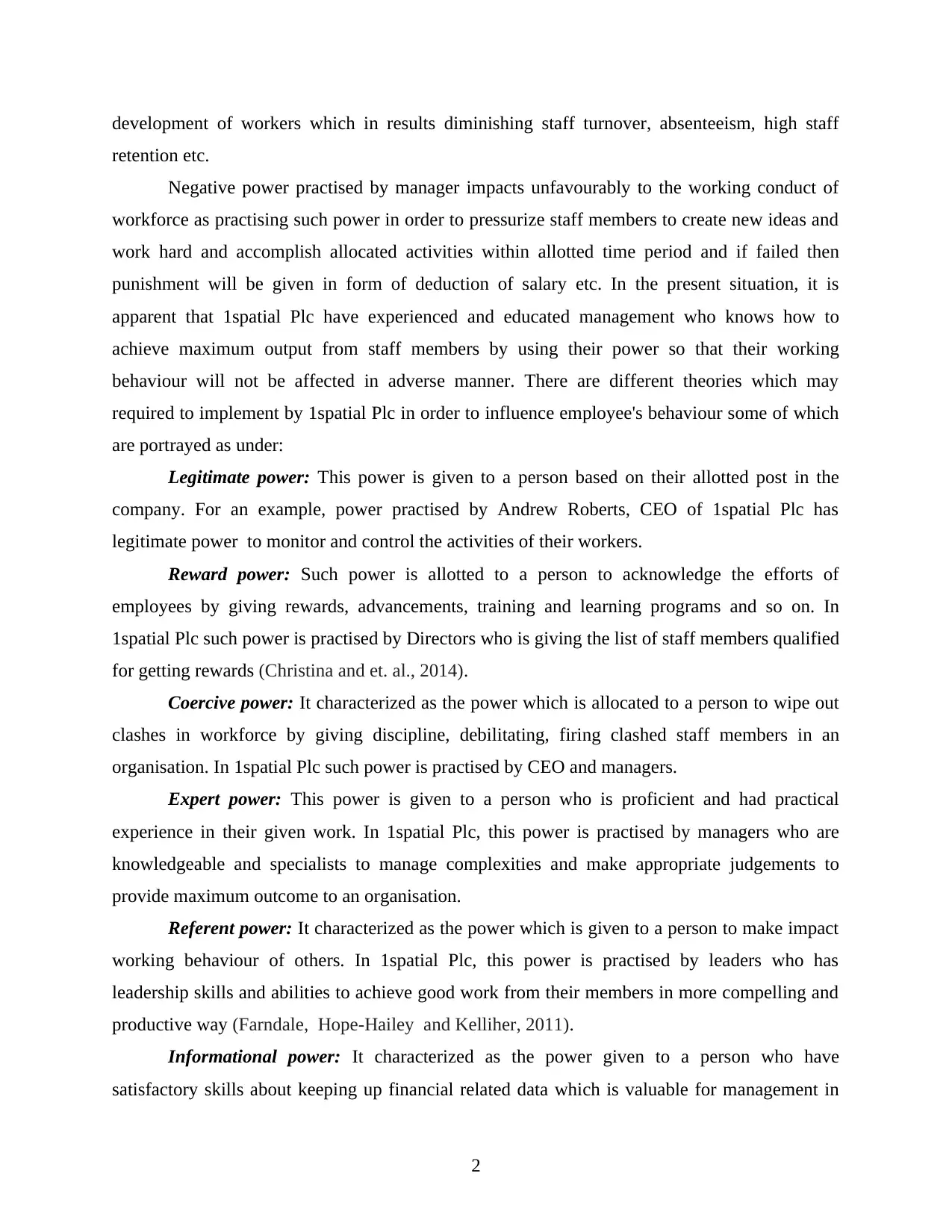
development of workers which in results diminishing staff turnover, absenteeism, high staff
retention etc.
Negative power practised by manager impacts unfavourably to the working conduct of
workforce as practising such power in order to pressurize staff members to create new ideas and
work hard and accomplish allocated activities within allotted time period and if failed then
punishment will be given in form of deduction of salary etc. In the present situation, it is
apparent that 1spatial Plc have experienced and educated management who knows how to
achieve maximum output from staff members by using their power so that their working
behaviour will not be affected in adverse manner. There are different theories which may
required to implement by 1spatial Plc in order to influence employee's behaviour some of which
are portrayed as under:
Legitimate power: This power is given to a person based on their allotted post in the
company. For an example, power practised by Andrew Roberts, CEO of 1spatial Plc has
legitimate power to monitor and control the activities of their workers.
Reward power: Such power is allotted to a person to acknowledge the efforts of
employees by giving rewards, advancements, training and learning programs and so on. In
1spatial Plc such power is practised by Directors who is giving the list of staff members qualified
for getting rewards (Christina and et. al., 2014).
Coercive power: It characterized as the power which is allocated to a person to wipe out
clashes in workforce by giving discipline, debilitating, firing clashed staff members in an
organisation. In 1spatial Plc such power is practised by CEO and managers.
Expert power: This power is given to a person who is proficient and had practical
experience in their given work. In 1spatial Plc, this power is practised by managers who are
knowledgeable and specialists to manage complexities and make appropriate judgements to
provide maximum outcome to an organisation.
Referent power: It characterized as the power which is given to a person to make impact
working behaviour of others. In 1spatial Plc, this power is practised by leaders who has
leadership skills and abilities to achieve good work from their members in more compelling and
productive way (Farndale, Hope-Hailey and Kelliher, 2011).
Informational power: It characterized as the power given to a person who have
satisfactory skills about keeping up financial related data which is valuable for management in
2
retention etc.
Negative power practised by manager impacts unfavourably to the working conduct of
workforce as practising such power in order to pressurize staff members to create new ideas and
work hard and accomplish allocated activities within allotted time period and if failed then
punishment will be given in form of deduction of salary etc. In the present situation, it is
apparent that 1spatial Plc have experienced and educated management who knows how to
achieve maximum output from staff members by using their power so that their working
behaviour will not be affected in adverse manner. There are different theories which may
required to implement by 1spatial Plc in order to influence employee's behaviour some of which
are portrayed as under:
Legitimate power: This power is given to a person based on their allotted post in the
company. For an example, power practised by Andrew Roberts, CEO of 1spatial Plc has
legitimate power to monitor and control the activities of their workers.
Reward power: Such power is allotted to a person to acknowledge the efforts of
employees by giving rewards, advancements, training and learning programs and so on. In
1spatial Plc such power is practised by Directors who is giving the list of staff members qualified
for getting rewards (Christina and et. al., 2014).
Coercive power: It characterized as the power which is allocated to a person to wipe out
clashes in workforce by giving discipline, debilitating, firing clashed staff members in an
organisation. In 1spatial Plc such power is practised by CEO and managers.
Expert power: This power is given to a person who is proficient and had practical
experience in their given work. In 1spatial Plc, this power is practised by managers who are
knowledgeable and specialists to manage complexities and make appropriate judgements to
provide maximum outcome to an organisation.
Referent power: It characterized as the power which is given to a person to make impact
working behaviour of others. In 1spatial Plc, this power is practised by leaders who has
leadership skills and abilities to achieve good work from their members in more compelling and
productive way (Farndale, Hope-Hailey and Kelliher, 2011).
Informational power: It characterized as the power given to a person who have
satisfactory skills about keeping up financial related data which is valuable for management in
2

setting an proper future plans and decisions. In 1spatial Plc, such power is practised by finance
managers of company who is responsible to maintain all kinds of financial reports, for example,
Profit and Loss a/c, Balance sheet, Cash Flow statement on specified time period.
Chanlat's characteristic related to political behaviour:
Chanlat explained the political behaviour through categorising them into three parts such
as decisional, personal and structural. It is applicable during recruitment process of staff in which
managers consider all qualities and passion that an individual possess so that their future
capabilities that could attained power and political behaviour. Michiavellian is the characteristics
of an individual possessed by the workers which enable them to pursue in political behaviour and
power. The other characteristics is structures which tells that managers of 1spatial Plc should
take actions and implement plans in more appropriate and systematic way.
Influence of politics on group and person:
Helpful in developing social astuteness, interpersonal influence, network ability and
sincerity: Office politics direct employees to gain knowledge about the occurings in an
organisation and influencing factors that can restrict or motivate them to work hard and give
their best efforts. For this, the management of 1spatial Plc is required to implement theories and
prepare tactics so as to guide the employees to towards achievement of organisational goals and
objectives. It requires communication transparency through which the employees are able to
communicate directly to the top authorities and inform them about the current situations at
market place (Francis, O’Connor and Curran, 2012).
Reduce the productivity of employees: It is the fact that employees who are involved in
organisational politics took more interest in telling the flaws and criticize the work of others
which leads to decreased performance as well as productivity level.
Influence of Culture in 1spatial Plc:
Organisational culture is the third crucial factor which states the concept of beliefs,
norms, values that are more useful to implement by company at workplace so that healthy
environment can be created. Culture influences the working behaviour and motivate them to
engage in all business activities in order to provide maximum support to achieve organisational
goals and objectives. In 1spatial Plc culture is formed with the consent of workforce and firms.
To maintain the good working culture, the management is needed to form a framework with
3
managers of company who is responsible to maintain all kinds of financial reports, for example,
Profit and Loss a/c, Balance sheet, Cash Flow statement on specified time period.
Chanlat's characteristic related to political behaviour:
Chanlat explained the political behaviour through categorising them into three parts such
as decisional, personal and structural. It is applicable during recruitment process of staff in which
managers consider all qualities and passion that an individual possess so that their future
capabilities that could attained power and political behaviour. Michiavellian is the characteristics
of an individual possessed by the workers which enable them to pursue in political behaviour and
power. The other characteristics is structures which tells that managers of 1spatial Plc should
take actions and implement plans in more appropriate and systematic way.
Influence of politics on group and person:
Helpful in developing social astuteness, interpersonal influence, network ability and
sincerity: Office politics direct employees to gain knowledge about the occurings in an
organisation and influencing factors that can restrict or motivate them to work hard and give
their best efforts. For this, the management of 1spatial Plc is required to implement theories and
prepare tactics so as to guide the employees to towards achievement of organisational goals and
objectives. It requires communication transparency through which the employees are able to
communicate directly to the top authorities and inform them about the current situations at
market place (Francis, O’Connor and Curran, 2012).
Reduce the productivity of employees: It is the fact that employees who are involved in
organisational politics took more interest in telling the flaws and criticize the work of others
which leads to decreased performance as well as productivity level.
Influence of Culture in 1spatial Plc:
Organisational culture is the third crucial factor which states the concept of beliefs,
norms, values that are more useful to implement by company at workplace so that healthy
environment can be created. Culture influences the working behaviour and motivate them to
engage in all business activities in order to provide maximum support to achieve organisational
goals and objectives. In 1spatial Plc culture is formed with the consent of workforce and firms.
To maintain the good working culture, the management is needed to form a framework with
3
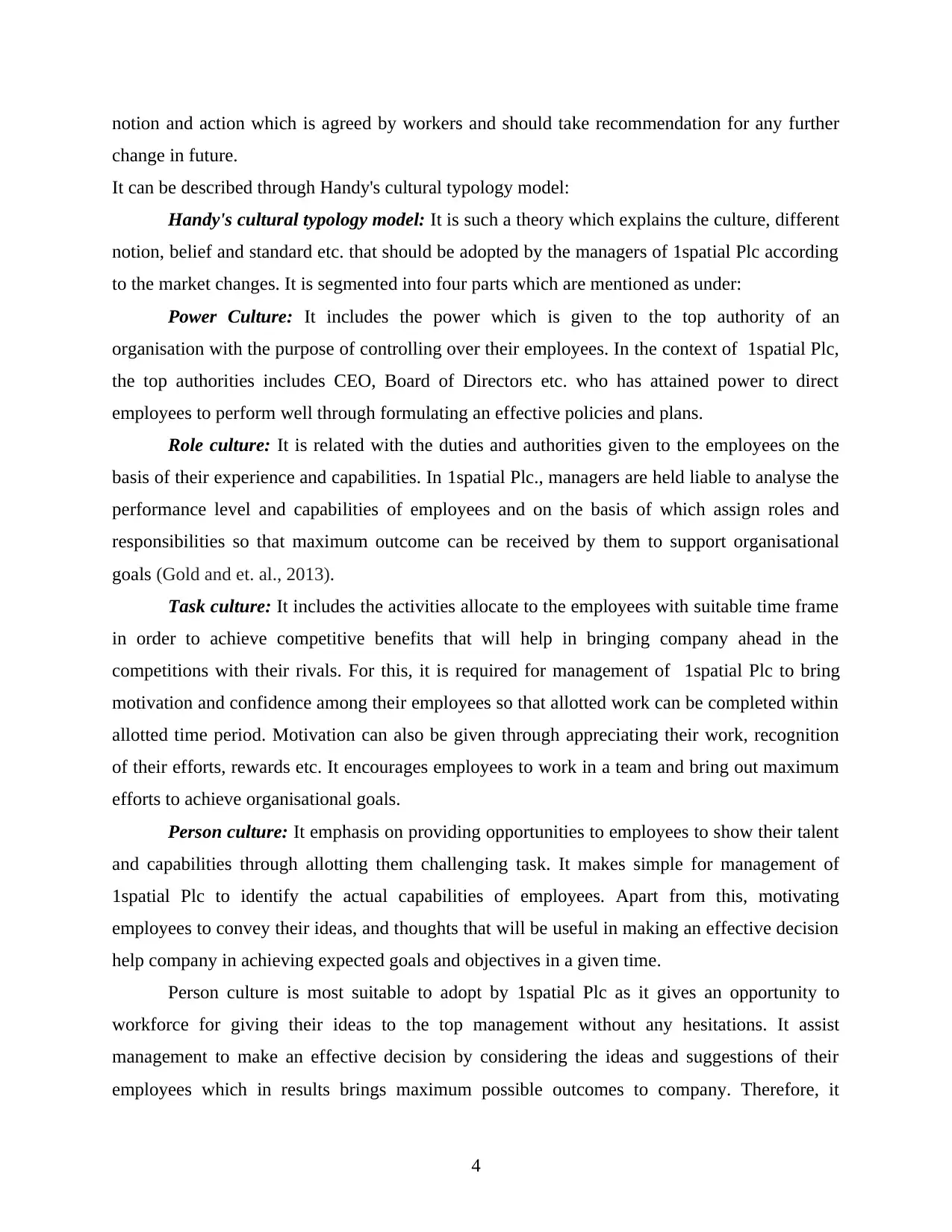
notion and action which is agreed by workers and should take recommendation for any further
change in future.
It can be described through Handy's cultural typology model:
Handy's cultural typology model: It is such a theory which explains the culture, different
notion, belief and standard etc. that should be adopted by the managers of 1spatial Plc according
to the market changes. It is segmented into four parts which are mentioned as under:
Power Culture: It includes the power which is given to the top authority of an
organisation with the purpose of controlling over their employees. In the context of 1spatial Plc,
the top authorities includes CEO, Board of Directors etc. who has attained power to direct
employees to perform well through formulating an effective policies and plans.
Role culture: It is related with the duties and authorities given to the employees on the
basis of their experience and capabilities. In 1spatial Plc., managers are held liable to analyse the
performance level and capabilities of employees and on the basis of which assign roles and
responsibilities so that maximum outcome can be received by them to support organisational
goals (Gold and et. al., 2013).
Task culture: It includes the activities allocate to the employees with suitable time frame
in order to achieve competitive benefits that will help in bringing company ahead in the
competitions with their rivals. For this, it is required for management of 1spatial Plc to bring
motivation and confidence among their employees so that allotted work can be completed within
allotted time period. Motivation can also be given through appreciating their work, recognition
of their efforts, rewards etc. It encourages employees to work in a team and bring out maximum
efforts to achieve organisational goals.
Person culture: It emphasis on providing opportunities to employees to show their talent
and capabilities through allotting them challenging task. It makes simple for management of
1spatial Plc to identify the actual capabilities of employees. Apart from this, motivating
employees to convey their ideas, and thoughts that will be useful in making an effective decision
help company in achieving expected goals and objectives in a given time.
Person culture is most suitable to adopt by 1spatial Plc as it gives an opportunity to
workforce for giving their ideas to the top management without any hesitations. It assist
management to make an effective decision by considering the ideas and suggestions of their
employees which in results brings maximum possible outcomes to company. Therefore, it
4
change in future.
It can be described through Handy's cultural typology model:
Handy's cultural typology model: It is such a theory which explains the culture, different
notion, belief and standard etc. that should be adopted by the managers of 1spatial Plc according
to the market changes. It is segmented into four parts which are mentioned as under:
Power Culture: It includes the power which is given to the top authority of an
organisation with the purpose of controlling over their employees. In the context of 1spatial Plc,
the top authorities includes CEO, Board of Directors etc. who has attained power to direct
employees to perform well through formulating an effective policies and plans.
Role culture: It is related with the duties and authorities given to the employees on the
basis of their experience and capabilities. In 1spatial Plc., managers are held liable to analyse the
performance level and capabilities of employees and on the basis of which assign roles and
responsibilities so that maximum outcome can be received by them to support organisational
goals (Gold and et. al., 2013).
Task culture: It includes the activities allocate to the employees with suitable time frame
in order to achieve competitive benefits that will help in bringing company ahead in the
competitions with their rivals. For this, it is required for management of 1spatial Plc to bring
motivation and confidence among their employees so that allotted work can be completed within
allotted time period. Motivation can also be given through appreciating their work, recognition
of their efforts, rewards etc. It encourages employees to work in a team and bring out maximum
efforts to achieve organisational goals.
Person culture: It emphasis on providing opportunities to employees to show their talent
and capabilities through allotting them challenging task. It makes simple for management of
1spatial Plc to identify the actual capabilities of employees. Apart from this, motivating
employees to convey their ideas, and thoughts that will be useful in making an effective decision
help company in achieving expected goals and objectives in a given time.
Person culture is most suitable to adopt by 1spatial Plc as it gives an opportunity to
workforce for giving their ideas to the top management without any hesitations. It assist
management to make an effective decision by considering the ideas and suggestions of their
employees which in results brings maximum possible outcomes to company. Therefore, it
4
Paraphrase This Document
Need a fresh take? Get an instant paraphrase of this document with our AI Paraphraser
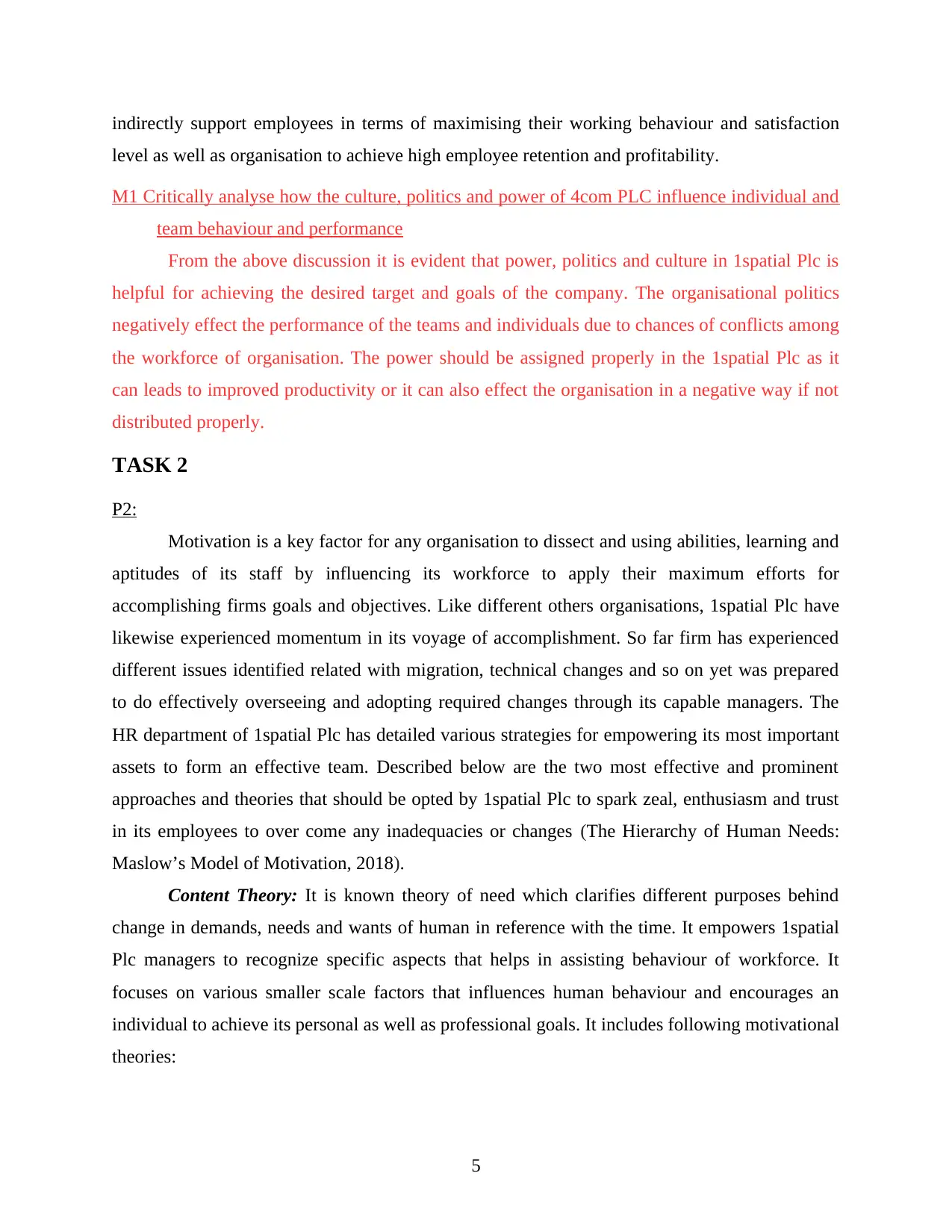
indirectly support employees in terms of maximising their working behaviour and satisfaction
level as well as organisation to achieve high employee retention and profitability.
M1 Critically analyse how the culture, politics and power of 4com PLC influence individual and
team behaviour and performance
From the above discussion it is evident that power, politics and culture in 1spatial Plc is
helpful for achieving the desired target and goals of the company. The organisational politics
negatively effect the performance of the teams and individuals due to chances of conflicts among
the workforce of organisation. The power should be assigned properly in the 1spatial Plc as it
can leads to improved productivity or it can also effect the organisation in a negative way if not
distributed properly.
TASK 2
P2:
Motivation is a key factor for any organisation to dissect and using abilities, learning and
aptitudes of its staff by influencing its workforce to apply their maximum efforts for
accomplishing firms goals and objectives. Like different others organisations, 1spatial Plc have
likewise experienced momentum in its voyage of accomplishment. So far firm has experienced
different issues identified related with migration, technical changes and so on yet was prepared
to do effectively overseeing and adopting required changes through its capable managers. The
HR department of 1spatial Plc has detailed various strategies for empowering its most important
assets to form an effective team. Described below are the two most effective and prominent
approaches and theories that should be opted by 1spatial Plc to spark zeal, enthusiasm and trust
in its employees to over come any inadequacies or changes (The Hierarchy of Human Needs:
Maslow’s Model of Motivation, 2018).
Content Theory: It is known theory of need which clarifies different purposes behind
change in demands, needs and wants of human in reference with the time. It empowers 1spatial
Plc managers to recognize specific aspects that helps in assisting behaviour of workforce. It
focuses on various smaller scale factors that influences human behaviour and encourages an
individual to achieve its personal as well as professional goals. It includes following motivational
theories:
5
level as well as organisation to achieve high employee retention and profitability.
M1 Critically analyse how the culture, politics and power of 4com PLC influence individual and
team behaviour and performance
From the above discussion it is evident that power, politics and culture in 1spatial Plc is
helpful for achieving the desired target and goals of the company. The organisational politics
negatively effect the performance of the teams and individuals due to chances of conflicts among
the workforce of organisation. The power should be assigned properly in the 1spatial Plc as it
can leads to improved productivity or it can also effect the organisation in a negative way if not
distributed properly.
TASK 2
P2:
Motivation is a key factor for any organisation to dissect and using abilities, learning and
aptitudes of its staff by influencing its workforce to apply their maximum efforts for
accomplishing firms goals and objectives. Like different others organisations, 1spatial Plc have
likewise experienced momentum in its voyage of accomplishment. So far firm has experienced
different issues identified related with migration, technical changes and so on yet was prepared
to do effectively overseeing and adopting required changes through its capable managers. The
HR department of 1spatial Plc has detailed various strategies for empowering its most important
assets to form an effective team. Described below are the two most effective and prominent
approaches and theories that should be opted by 1spatial Plc to spark zeal, enthusiasm and trust
in its employees to over come any inadequacies or changes (The Hierarchy of Human Needs:
Maslow’s Model of Motivation, 2018).
Content Theory: It is known theory of need which clarifies different purposes behind
change in demands, needs and wants of human in reference with the time. It empowers 1spatial
Plc managers to recognize specific aspects that helps in assisting behaviour of workforce. It
focuses on various smaller scale factors that influences human behaviour and encourages an
individual to achieve its personal as well as professional goals. It includes following motivational
theories:
5
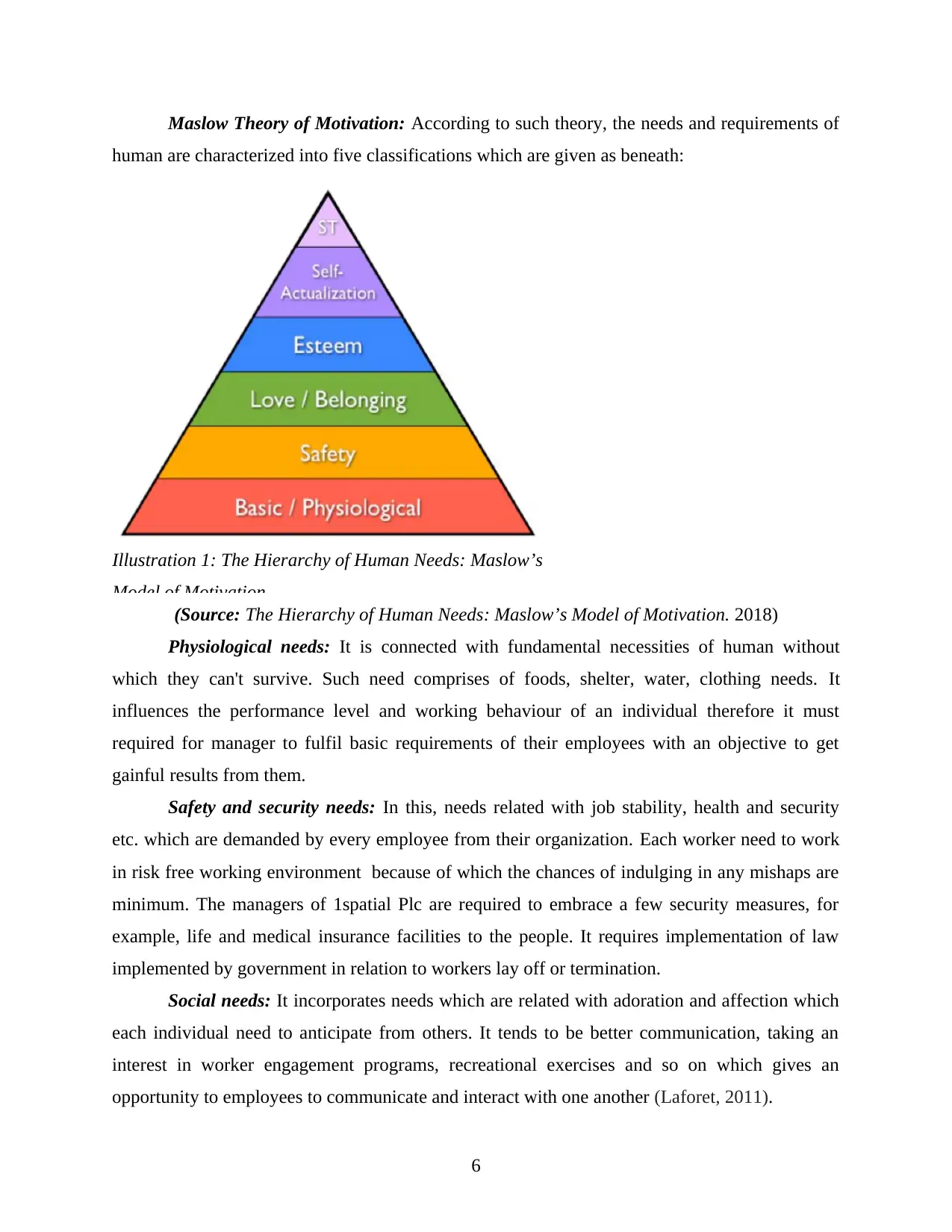
Maslow Theory of Motivation: According to such theory, the needs and requirements of
human are characterized into five classifications which are given as beneath:
Illustration 1: The Hierarchy of Human Needs: Maslow’s
Model of Motivation
(Source: The Hierarchy of Human Needs: Maslow’s Model of Motivation. 2018)
Physiological needs: It is connected with fundamental necessities of human without
which they can't survive. Such need comprises of foods, shelter, water, clothing needs. It
influences the performance level and working behaviour of an individual therefore it must
required for manager to fulfil basic requirements of their employees with an objective to get
gainful results from them.
Safety and security needs: In this, needs related with job stability, health and security
etc. which are demanded by every employee from their organization. Each worker need to work
in risk free working environment because of which the chances of indulging in any mishaps are
minimum. The managers of 1spatial Plc are required to embrace a few security measures, for
example, life and medical insurance facilities to the people. It requires implementation of law
implemented by government in relation to workers lay off or termination.
Social needs: It incorporates needs which are related with adoration and affection which
each individual need to anticipate from others. It tends to be better communication, taking an
interest in worker engagement programs, recreational exercises and so on which gives an
opportunity to employees to communicate and interact with one another (Laforet, 2011).
6
human are characterized into five classifications which are given as beneath:
Illustration 1: The Hierarchy of Human Needs: Maslow’s
Model of Motivation
(Source: The Hierarchy of Human Needs: Maslow’s Model of Motivation. 2018)
Physiological needs: It is connected with fundamental necessities of human without
which they can't survive. Such need comprises of foods, shelter, water, clothing needs. It
influences the performance level and working behaviour of an individual therefore it must
required for manager to fulfil basic requirements of their employees with an objective to get
gainful results from them.
Safety and security needs: In this, needs related with job stability, health and security
etc. which are demanded by every employee from their organization. Each worker need to work
in risk free working environment because of which the chances of indulging in any mishaps are
minimum. The managers of 1spatial Plc are required to embrace a few security measures, for
example, life and medical insurance facilities to the people. It requires implementation of law
implemented by government in relation to workers lay off or termination.
Social needs: It incorporates needs which are related with adoration and affection which
each individual need to anticipate from others. It tends to be better communication, taking an
interest in worker engagement programs, recreational exercises and so on which gives an
opportunity to employees to communicate and interact with one another (Laforet, 2011).
6
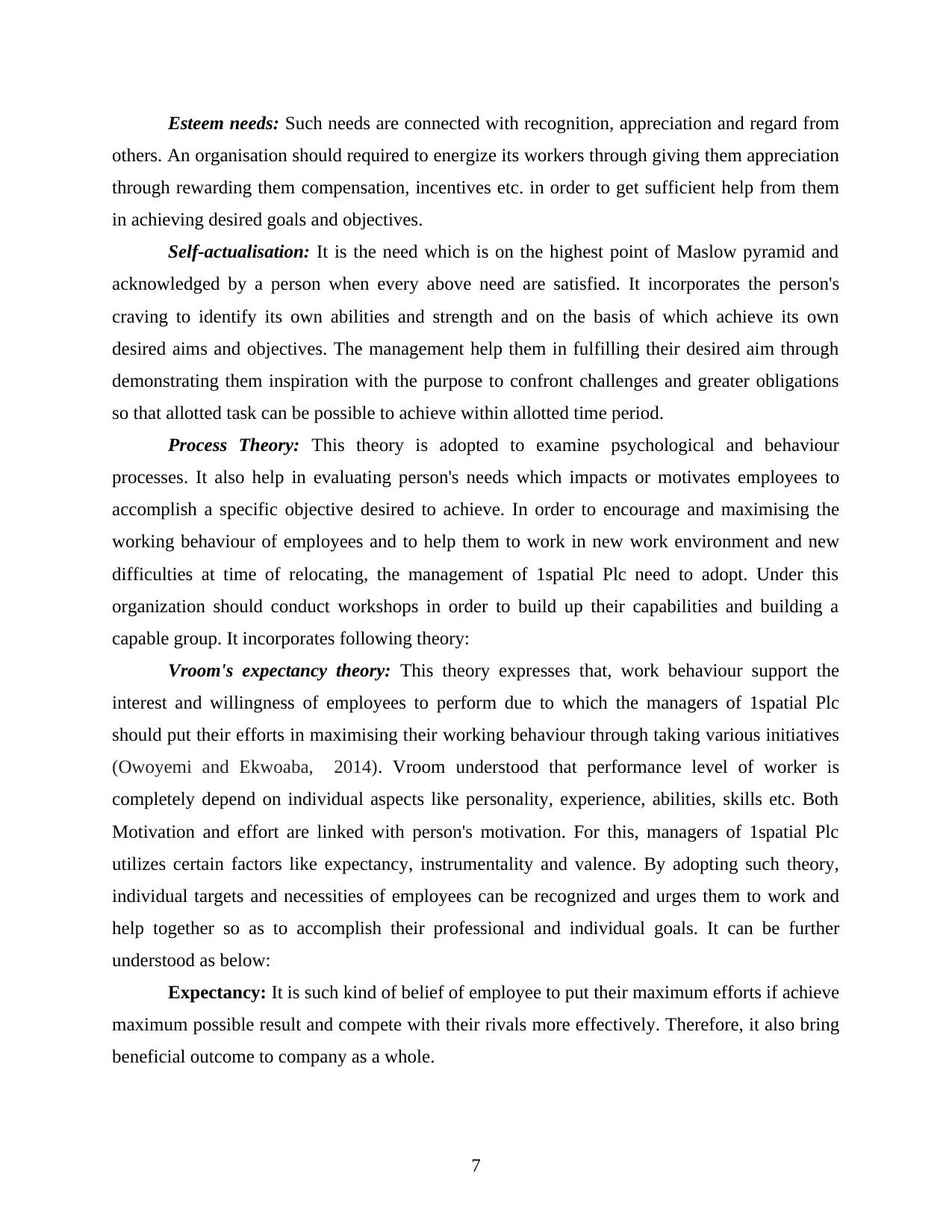
Esteem needs: Such needs are connected with recognition, appreciation and regard from
others. An organisation should required to energize its workers through giving them appreciation
through rewarding them compensation, incentives etc. in order to get sufficient help from them
in achieving desired goals and objectives.
Self-actualisation: It is the need which is on the highest point of Maslow pyramid and
acknowledged by a person when every above need are satisfied. It incorporates the person's
craving to identify its own abilities and strength and on the basis of which achieve its own
desired aims and objectives. The management help them in fulfilling their desired aim through
demonstrating them inspiration with the purpose to confront challenges and greater obligations
so that allotted task can be possible to achieve within allotted time period.
Process Theory: This theory is adopted to examine psychological and behaviour
processes. It also help in evaluating person's needs which impacts or motivates employees to
accomplish a specific objective desired to achieve. In order to encourage and maximising the
working behaviour of employees and to help them to work in new work environment and new
difficulties at time of relocating, the management of 1spatial Plc need to adopt. Under this
organization should conduct workshops in order to build up their capabilities and building a
capable group. It incorporates following theory:
Vroom's expectancy theory: This theory expresses that, work behaviour support the
interest and willingness of employees to perform due to which the managers of 1spatial Plc
should put their efforts in maximising their working behaviour through taking various initiatives
(Owoyemi and Ekwoaba, 2014). Vroom understood that performance level of worker is
completely depend on individual aspects like personality, experience, abilities, skills etc. Both
Motivation and effort are linked with person's motivation. For this, managers of 1spatial Plc
utilizes certain factors like expectancy, instrumentality and valence. By adopting such theory,
individual targets and necessities of employees can be recognized and urges them to work and
help together so as to accomplish their professional and individual goals. It can be further
understood as below:
Expectancy: It is such kind of belief of employee to put their maximum efforts if achieve
maximum possible result and compete with their rivals more effectively. Therefore, it also bring
beneficial outcome to company as a whole.
7
others. An organisation should required to energize its workers through giving them appreciation
through rewarding them compensation, incentives etc. in order to get sufficient help from them
in achieving desired goals and objectives.
Self-actualisation: It is the need which is on the highest point of Maslow pyramid and
acknowledged by a person when every above need are satisfied. It incorporates the person's
craving to identify its own abilities and strength and on the basis of which achieve its own
desired aims and objectives. The management help them in fulfilling their desired aim through
demonstrating them inspiration with the purpose to confront challenges and greater obligations
so that allotted task can be possible to achieve within allotted time period.
Process Theory: This theory is adopted to examine psychological and behaviour
processes. It also help in evaluating person's needs which impacts or motivates employees to
accomplish a specific objective desired to achieve. In order to encourage and maximising the
working behaviour of employees and to help them to work in new work environment and new
difficulties at time of relocating, the management of 1spatial Plc need to adopt. Under this
organization should conduct workshops in order to build up their capabilities and building a
capable group. It incorporates following theory:
Vroom's expectancy theory: This theory expresses that, work behaviour support the
interest and willingness of employees to perform due to which the managers of 1spatial Plc
should put their efforts in maximising their working behaviour through taking various initiatives
(Owoyemi and Ekwoaba, 2014). Vroom understood that performance level of worker is
completely depend on individual aspects like personality, experience, abilities, skills etc. Both
Motivation and effort are linked with person's motivation. For this, managers of 1spatial Plc
utilizes certain factors like expectancy, instrumentality and valence. By adopting such theory,
individual targets and necessities of employees can be recognized and urges them to work and
help together so as to accomplish their professional and individual goals. It can be further
understood as below:
Expectancy: It is such kind of belief of employee to put their maximum efforts if achieve
maximum possible result and compete with their rivals more effectively. Therefore, it also bring
beneficial outcome to company as a whole.
7
Secure Best Marks with AI Grader
Need help grading? Try our AI Grader for instant feedback on your assignments.
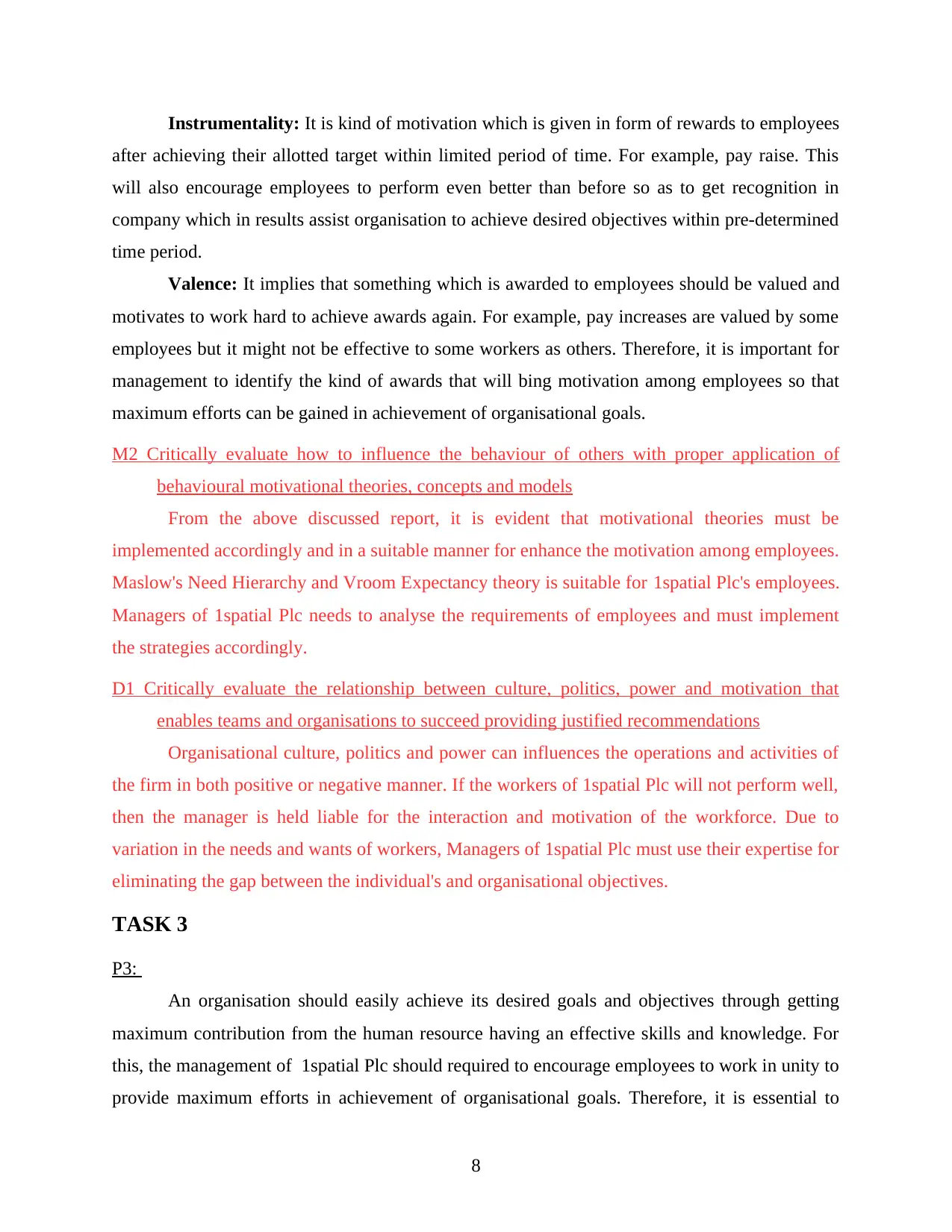
Instrumentality: It is kind of motivation which is given in form of rewards to employees
after achieving their allotted target within limited period of time. For example, pay raise. This
will also encourage employees to perform even better than before so as to get recognition in
company which in results assist organisation to achieve desired objectives within pre-determined
time period.
Valence: It implies that something which is awarded to employees should be valued and
motivates to work hard to achieve awards again. For example, pay increases are valued by some
employees but it might not be effective to some workers as others. Therefore, it is important for
management to identify the kind of awards that will bing motivation among employees so that
maximum efforts can be gained in achievement of organisational goals.
M2 Critically evaluate how to influence the behaviour of others with proper application of
behavioural motivational theories, concepts and models
From the above discussed report, it is evident that motivational theories must be
implemented accordingly and in a suitable manner for enhance the motivation among employees.
Maslow's Need Hierarchy and Vroom Expectancy theory is suitable for 1spatial Plc's employees.
Managers of 1spatial Plc needs to analyse the requirements of employees and must implement
the strategies accordingly.
D1 Critically evaluate the relationship between culture, politics, power and motivation that
enables teams and organisations to succeed providing justified recommendations
Organisational culture, politics and power can influences the operations and activities of
the firm in both positive or negative manner. If the workers of 1spatial Plc will not perform well,
then the manager is held liable for the interaction and motivation of the workforce. Due to
variation in the needs and wants of workers, Managers of 1spatial Plc must use their expertise for
eliminating the gap between the individual's and organisational objectives.
TASK 3
P3:
An organisation should easily achieve its desired goals and objectives through getting
maximum contribution from the human resource having an effective skills and knowledge. For
this, the management of 1spatial Plc should required to encourage employees to work in unity to
provide maximum efforts in achievement of organisational goals. Therefore, it is essential to
8
after achieving their allotted target within limited period of time. For example, pay raise. This
will also encourage employees to perform even better than before so as to get recognition in
company which in results assist organisation to achieve desired objectives within pre-determined
time period.
Valence: It implies that something which is awarded to employees should be valued and
motivates to work hard to achieve awards again. For example, pay increases are valued by some
employees but it might not be effective to some workers as others. Therefore, it is important for
management to identify the kind of awards that will bing motivation among employees so that
maximum efforts can be gained in achievement of organisational goals.
M2 Critically evaluate how to influence the behaviour of others with proper application of
behavioural motivational theories, concepts and models
From the above discussed report, it is evident that motivational theories must be
implemented accordingly and in a suitable manner for enhance the motivation among employees.
Maslow's Need Hierarchy and Vroom Expectancy theory is suitable for 1spatial Plc's employees.
Managers of 1spatial Plc needs to analyse the requirements of employees and must implement
the strategies accordingly.
D1 Critically evaluate the relationship between culture, politics, power and motivation that
enables teams and organisations to succeed providing justified recommendations
Organisational culture, politics and power can influences the operations and activities of
the firm in both positive or negative manner. If the workers of 1spatial Plc will not perform well,
then the manager is held liable for the interaction and motivation of the workforce. Due to
variation in the needs and wants of workers, Managers of 1spatial Plc must use their expertise for
eliminating the gap between the individual's and organisational objectives.
TASK 3
P3:
An organisation should easily achieve its desired goals and objectives through getting
maximum contribution from the human resource having an effective skills and knowledge. For
this, the management of 1spatial Plc should required to encourage employees to work in unity to
provide maximum efforts in achievement of organisational goals. Therefore, it is essential to
8
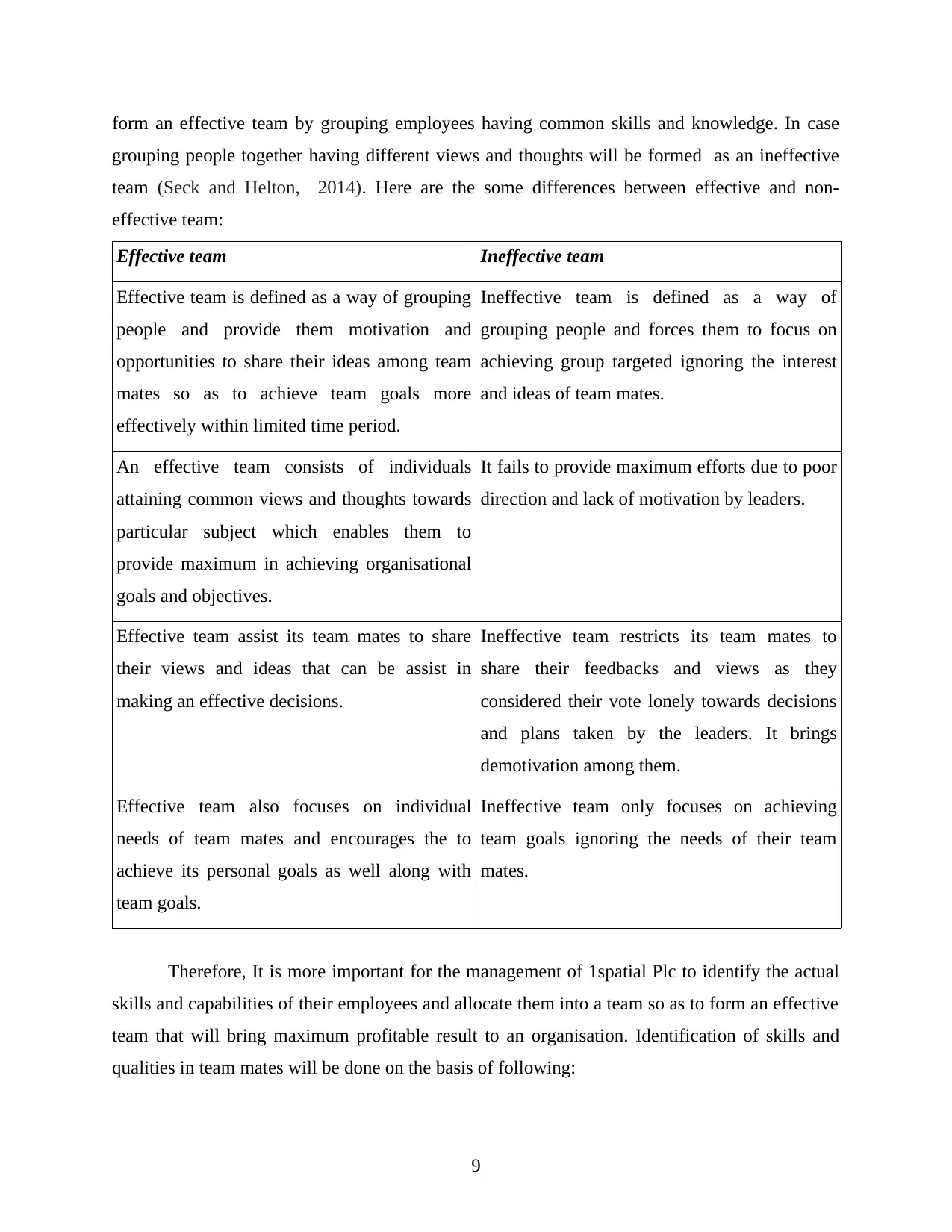
form an effective team by grouping employees having common skills and knowledge. In case
grouping people together having different views and thoughts will be formed as an ineffective
team (Seck and Helton, 2014). Here are the some differences between effective and non-
effective team:
Effective team Ineffective team
Effective team is defined as a way of grouping
people and provide them motivation and
opportunities to share their ideas among team
mates so as to achieve team goals more
effectively within limited time period.
Ineffective team is defined as a way of
grouping people and forces them to focus on
achieving group targeted ignoring the interest
and ideas of team mates.
An effective team consists of individuals
attaining common views and thoughts towards
particular subject which enables them to
provide maximum in achieving organisational
goals and objectives.
It fails to provide maximum efforts due to poor
direction and lack of motivation by leaders.
Effective team assist its team mates to share
their views and ideas that can be assist in
making an effective decisions.
Ineffective team restricts its team mates to
share their feedbacks and views as they
considered their vote lonely towards decisions
and plans taken by the leaders. It brings
demotivation among them.
Effective team also focuses on individual
needs of team mates and encourages the to
achieve its personal goals as well along with
team goals.
Ineffective team only focuses on achieving
team goals ignoring the needs of their team
mates.
Therefore, It is more important for the management of 1spatial Plc to identify the actual
skills and capabilities of their employees and allocate them into a team so as to form an effective
team that will bring maximum profitable result to an organisation. Identification of skills and
qualities in team mates will be done on the basis of following:
9
grouping people together having different views and thoughts will be formed as an ineffective
team (Seck and Helton, 2014). Here are the some differences between effective and non-
effective team:
Effective team Ineffective team
Effective team is defined as a way of grouping
people and provide them motivation and
opportunities to share their ideas among team
mates so as to achieve team goals more
effectively within limited time period.
Ineffective team is defined as a way of
grouping people and forces them to focus on
achieving group targeted ignoring the interest
and ideas of team mates.
An effective team consists of individuals
attaining common views and thoughts towards
particular subject which enables them to
provide maximum in achieving organisational
goals and objectives.
It fails to provide maximum efforts due to poor
direction and lack of motivation by leaders.
Effective team assist its team mates to share
their views and ideas that can be assist in
making an effective decisions.
Ineffective team restricts its team mates to
share their feedbacks and views as they
considered their vote lonely towards decisions
and plans taken by the leaders. It brings
demotivation among them.
Effective team also focuses on individual
needs of team mates and encourages the to
achieve its personal goals as well along with
team goals.
Ineffective team only focuses on achieving
team goals ignoring the needs of their team
mates.
Therefore, It is more important for the management of 1spatial Plc to identify the actual
skills and capabilities of their employees and allocate them into a team so as to form an effective
team that will bring maximum profitable result to an organisation. Identification of skills and
qualities in team mates will be done on the basis of following:
9
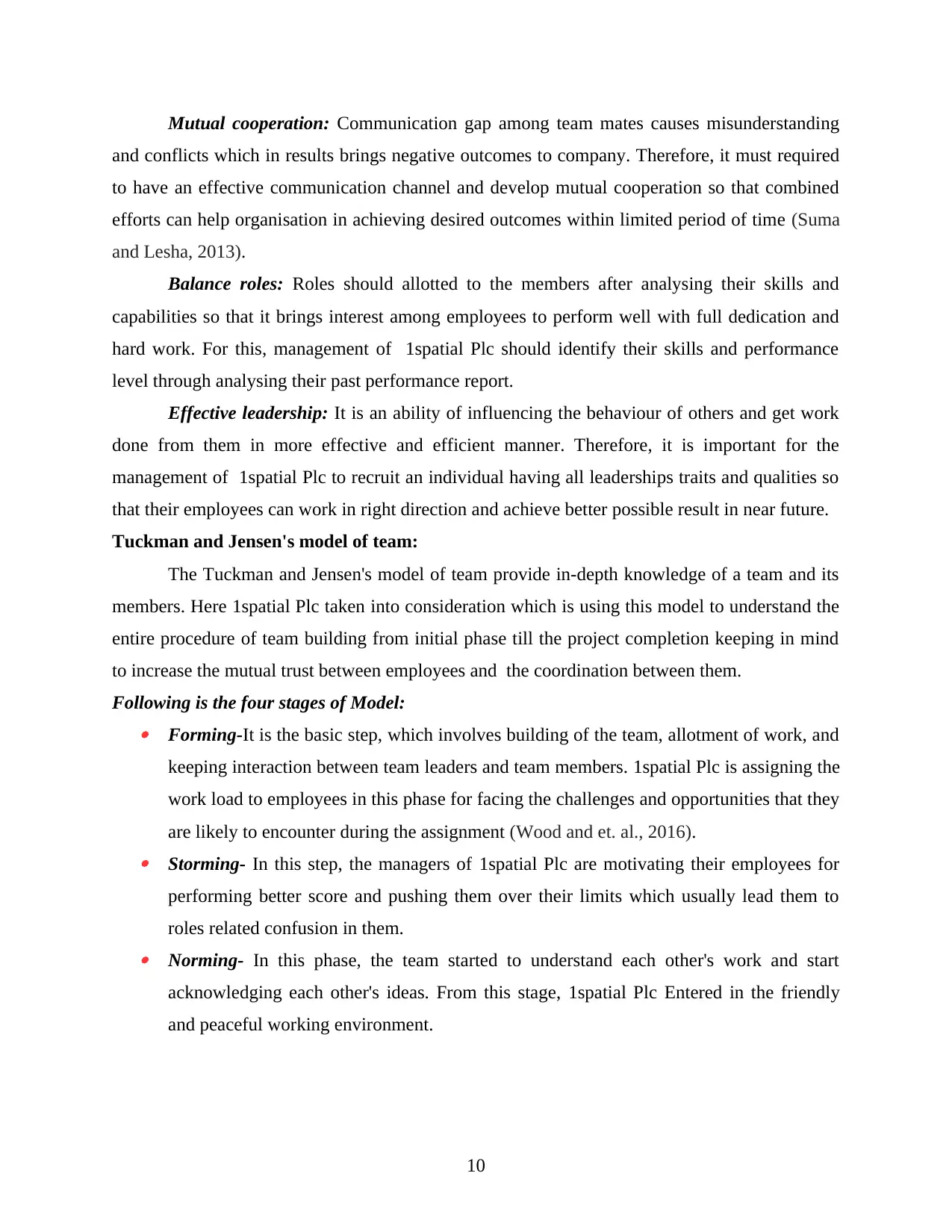
Mutual cooperation: Communication gap among team mates causes misunderstanding
and conflicts which in results brings negative outcomes to company. Therefore, it must required
to have an effective communication channel and develop mutual cooperation so that combined
efforts can help organisation in achieving desired outcomes within limited period of time (Suma
and Lesha, 2013).
Balance roles: Roles should allotted to the members after analysing their skills and
capabilities so that it brings interest among employees to perform well with full dedication and
hard work. For this, management of 1spatial Plc should identify their skills and performance
level through analysing their past performance report.
Effective leadership: It is an ability of influencing the behaviour of others and get work
done from them in more effective and efficient manner. Therefore, it is important for the
management of 1spatial Plc to recruit an individual having all leaderships traits and qualities so
that their employees can work in right direction and achieve better possible result in near future.
Tuckman and Jensen's model of team:
The Tuckman and Jensen's model of team provide in-depth knowledge of a team and its
members. Here 1spatial Plc taken into consideration which is using this model to understand the
entire procedure of team building from initial phase till the project completion keeping in mind
to increase the mutual trust between employees and the coordination between them.
Following is the four stages of Model: Forming-It is the basic step, which involves building of the team, allotment of work, and
keeping interaction between team leaders and team members. 1spatial Plc is assigning the
work load to employees in this phase for facing the challenges and opportunities that they
are likely to encounter during the assignment (Wood and et. al., 2016). Storming- In this step, the managers of 1spatial Plc are motivating their employees for
performing better score and pushing them over their limits which usually lead them to
roles related confusion in them. Norming- In this phase, the team started to understand each other's work and start
acknowledging each other's ideas. From this stage, 1spatial Plc Entered in the friendly
and peaceful working environment.
10
and conflicts which in results brings negative outcomes to company. Therefore, it must required
to have an effective communication channel and develop mutual cooperation so that combined
efforts can help organisation in achieving desired outcomes within limited period of time (Suma
and Lesha, 2013).
Balance roles: Roles should allotted to the members after analysing their skills and
capabilities so that it brings interest among employees to perform well with full dedication and
hard work. For this, management of 1spatial Plc should identify their skills and performance
level through analysing their past performance report.
Effective leadership: It is an ability of influencing the behaviour of others and get work
done from them in more effective and efficient manner. Therefore, it is important for the
management of 1spatial Plc to recruit an individual having all leaderships traits and qualities so
that their employees can work in right direction and achieve better possible result in near future.
Tuckman and Jensen's model of team:
The Tuckman and Jensen's model of team provide in-depth knowledge of a team and its
members. Here 1spatial Plc taken into consideration which is using this model to understand the
entire procedure of team building from initial phase till the project completion keeping in mind
to increase the mutual trust between employees and the coordination between them.
Following is the four stages of Model: Forming-It is the basic step, which involves building of the team, allotment of work, and
keeping interaction between team leaders and team members. 1spatial Plc is assigning the
work load to employees in this phase for facing the challenges and opportunities that they
are likely to encounter during the assignment (Wood and et. al., 2016). Storming- In this step, the managers of 1spatial Plc are motivating their employees for
performing better score and pushing them over their limits which usually lead them to
roles related confusion in them. Norming- In this phase, the team started to understand each other's work and start
acknowledging each other's ideas. From this stage, 1spatial Plc Entered in the friendly
and peaceful working environment.
10
Paraphrase This Document
Need a fresh take? Get an instant paraphrase of this document with our AI Paraphraser
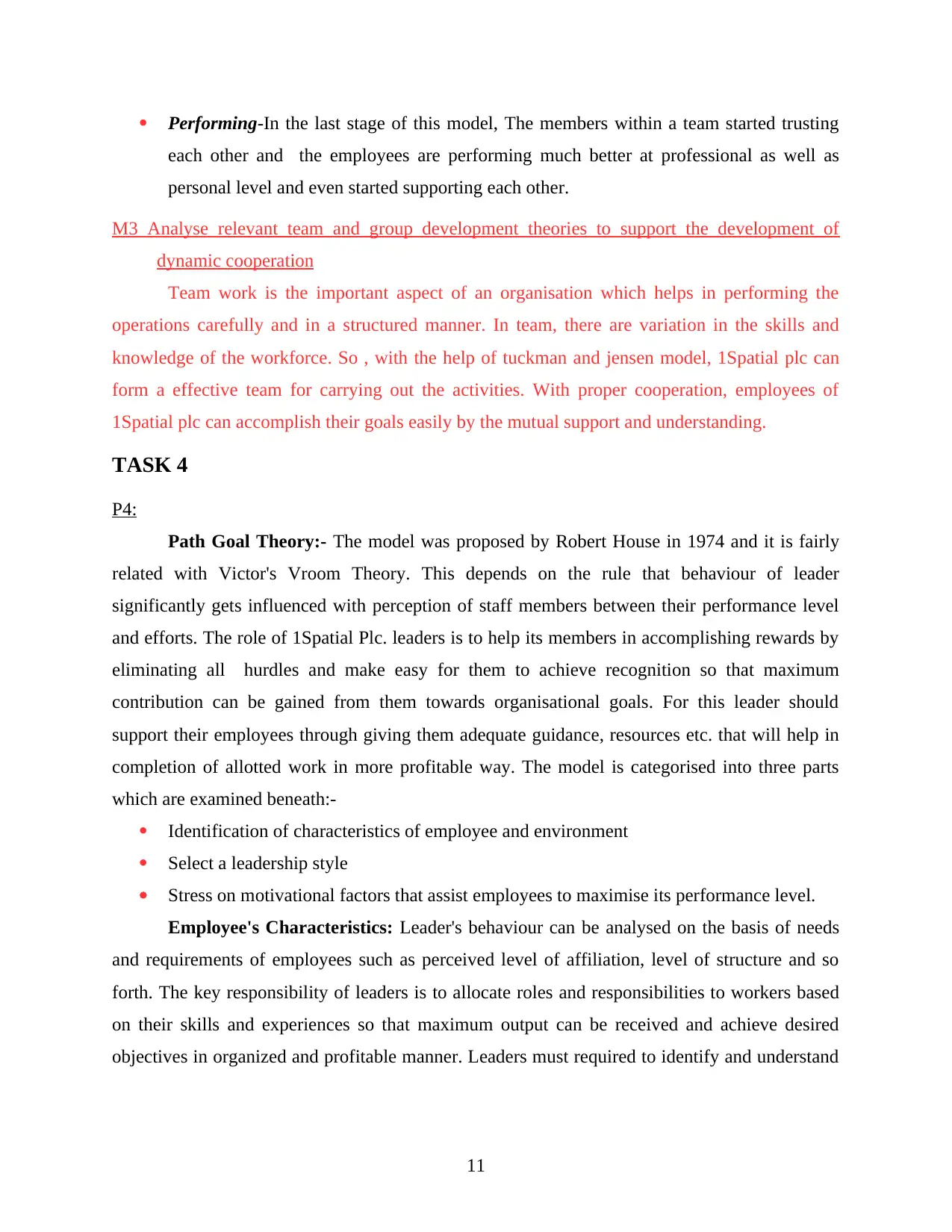
Performing-In the last stage of this model, The members within a team started trusting
each other and the employees are performing much better at professional as well as
personal level and even started supporting each other.
M3 Analyse relevant team and group development theories to support the development of
dynamic cooperation
Team work is the important aspect of an organisation which helps in performing the
operations carefully and in a structured manner. In team, there are variation in the skills and
knowledge of the workforce. So , with the help of tuckman and jensen model, 1Spatial plc can
form a effective team for carrying out the activities. With proper cooperation, employees of
1Spatial plc can accomplish their goals easily by the mutual support and understanding.
TASK 4
P4:
Path Goal Theory:- The model was proposed by Robert House in 1974 and it is fairly
related with Victor's Vroom Theory. This depends on the rule that behaviour of leader
significantly gets influenced with perception of staff members between their performance level
and efforts. The role of 1Spatial Plc. leaders is to help its members in accomplishing rewards by
eliminating all hurdles and make easy for them to achieve recognition so that maximum
contribution can be gained from them towards organisational goals. For this leader should
support their employees through giving them adequate guidance, resources etc. that will help in
completion of allotted work in more profitable way. The model is categorised into three parts
which are examined beneath:-
Identification of characteristics of employee and environment
Select a leadership style
Stress on motivational factors that assist employees to maximise its performance level.
Employee's Characteristics: Leader's behaviour can be analysed on the basis of needs
and requirements of employees such as perceived level of affiliation, level of structure and so
forth. The key responsibility of leaders is to allocate roles and responsibilities to workers based
on their skills and experiences so that maximum output can be received and achieve desired
objectives in organized and profitable manner. Leaders must required to identify and understand
11
each other and the employees are performing much better at professional as well as
personal level and even started supporting each other.
M3 Analyse relevant team and group development theories to support the development of
dynamic cooperation
Team work is the important aspect of an organisation which helps in performing the
operations carefully and in a structured manner. In team, there are variation in the skills and
knowledge of the workforce. So , with the help of tuckman and jensen model, 1Spatial plc can
form a effective team for carrying out the activities. With proper cooperation, employees of
1Spatial plc can accomplish their goals easily by the mutual support and understanding.
TASK 4
P4:
Path Goal Theory:- The model was proposed by Robert House in 1974 and it is fairly
related with Victor's Vroom Theory. This depends on the rule that behaviour of leader
significantly gets influenced with perception of staff members between their performance level
and efforts. The role of 1Spatial Plc. leaders is to help its members in accomplishing rewards by
eliminating all hurdles and make easy for them to achieve recognition so that maximum
contribution can be gained from them towards organisational goals. For this leader should
support their employees through giving them adequate guidance, resources etc. that will help in
completion of allotted work in more profitable way. The model is categorised into three parts
which are examined beneath:-
Identification of characteristics of employee and environment
Select a leadership style
Stress on motivational factors that assist employees to maximise its performance level.
Employee's Characteristics: Leader's behaviour can be analysed on the basis of needs
and requirements of employees such as perceived level of affiliation, level of structure and so
forth. The key responsibility of leaders is to allocate roles and responsibilities to workers based
on their skills and experiences so that maximum output can be received and achieve desired
objectives in organized and profitable manner. Leaders must required to identify and understand
11
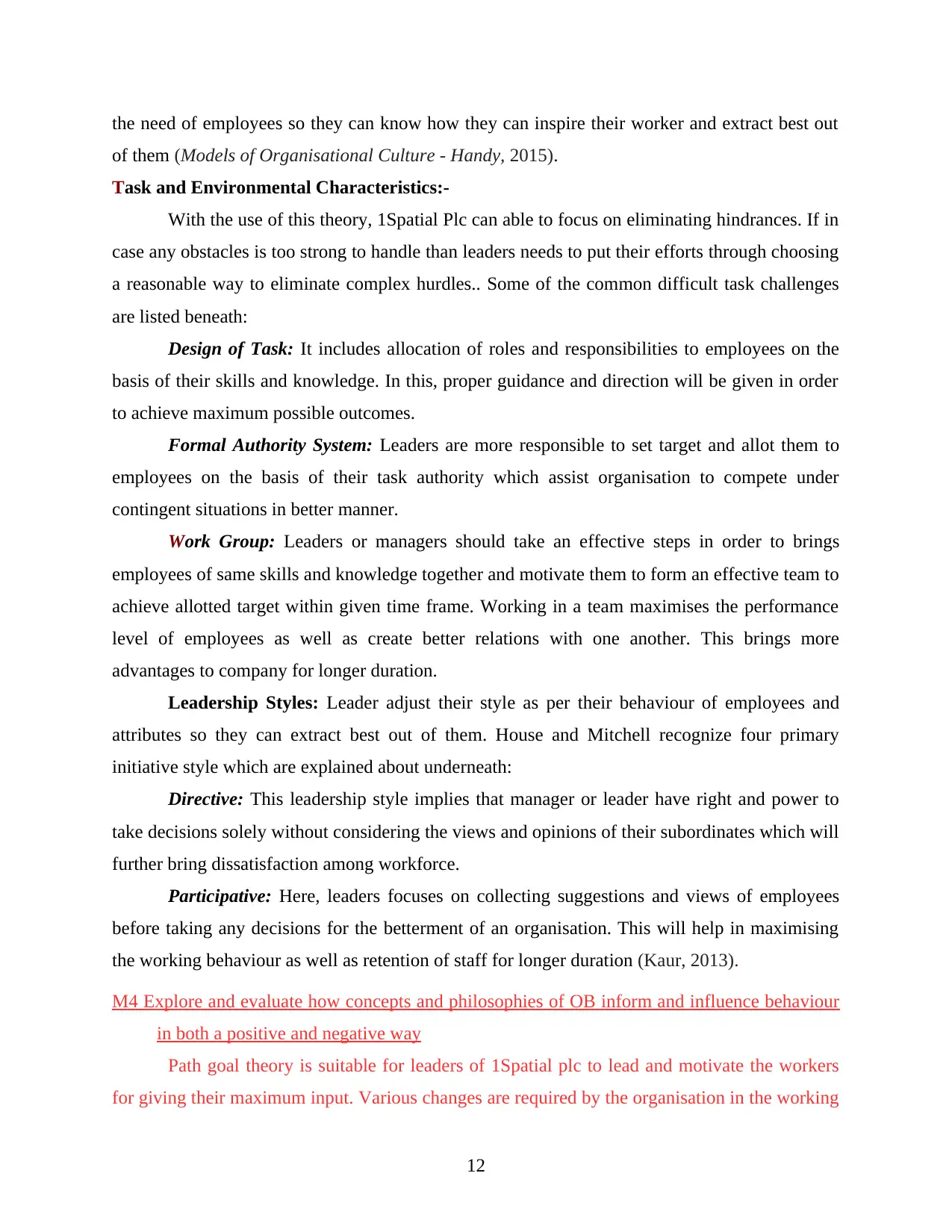
the need of employees so they can know how they can inspire their worker and extract best out
of them (Models of Organisational Culture - Handy, 2015).
Task and Environmental Characteristics:-
With the use of this theory, 1Spatial Plc can able to focus on eliminating hindrances. If in
case any obstacles is too strong to handle than leaders needs to put their efforts through choosing
a reasonable way to eliminate complex hurdles.. Some of the common difficult task challenges
are listed beneath:
Design of Task: It includes allocation of roles and responsibilities to employees on the
basis of their skills and knowledge. In this, proper guidance and direction will be given in order
to achieve maximum possible outcomes.
Formal Authority System: Leaders are more responsible to set target and allot them to
employees on the basis of their task authority which assist organisation to compete under
contingent situations in better manner.
Work Group: Leaders or managers should take an effective steps in order to brings
employees of same skills and knowledge together and motivate them to form an effective team to
achieve allotted target within given time frame. Working in a team maximises the performance
level of employees as well as create better relations with one another. This brings more
advantages to company for longer duration.
Leadership Styles: Leader adjust their style as per their behaviour of employees and
attributes so they can extract best out of them. House and Mitchell recognize four primary
initiative style which are explained about underneath:
Directive: This leadership style implies that manager or leader have right and power to
take decisions solely without considering the views and opinions of their subordinates which will
further bring dissatisfaction among workforce.
Participative: Here, leaders focuses on collecting suggestions and views of employees
before taking any decisions for the betterment of an organisation. This will help in maximising
the working behaviour as well as retention of staff for longer duration (Kaur, 2013).
M4 Explore and evaluate how concepts and philosophies of OB inform and influence behaviour
in both a positive and negative way
Path goal theory is suitable for leaders of 1Spatial plc to lead and motivate the workers
for giving their maximum input. Various changes are required by the organisation in the working
12
of them (Models of Organisational Culture - Handy, 2015).
Task and Environmental Characteristics:-
With the use of this theory, 1Spatial Plc can able to focus on eliminating hindrances. If in
case any obstacles is too strong to handle than leaders needs to put their efforts through choosing
a reasonable way to eliminate complex hurdles.. Some of the common difficult task challenges
are listed beneath:
Design of Task: It includes allocation of roles and responsibilities to employees on the
basis of their skills and knowledge. In this, proper guidance and direction will be given in order
to achieve maximum possible outcomes.
Formal Authority System: Leaders are more responsible to set target and allot them to
employees on the basis of their task authority which assist organisation to compete under
contingent situations in better manner.
Work Group: Leaders or managers should take an effective steps in order to brings
employees of same skills and knowledge together and motivate them to form an effective team to
achieve allotted target within given time frame. Working in a team maximises the performance
level of employees as well as create better relations with one another. This brings more
advantages to company for longer duration.
Leadership Styles: Leader adjust their style as per their behaviour of employees and
attributes so they can extract best out of them. House and Mitchell recognize four primary
initiative style which are explained about underneath:
Directive: This leadership style implies that manager or leader have right and power to
take decisions solely without considering the views and opinions of their subordinates which will
further bring dissatisfaction among workforce.
Participative: Here, leaders focuses on collecting suggestions and views of employees
before taking any decisions for the betterment of an organisation. This will help in maximising
the working behaviour as well as retention of staff for longer duration (Kaur, 2013).
M4 Explore and evaluate how concepts and philosophies of OB inform and influence behaviour
in both a positive and negative way
Path goal theory is suitable for leaders of 1Spatial plc to lead and motivate the workers
for giving their maximum input. Various changes are required by the organisation in the working
12
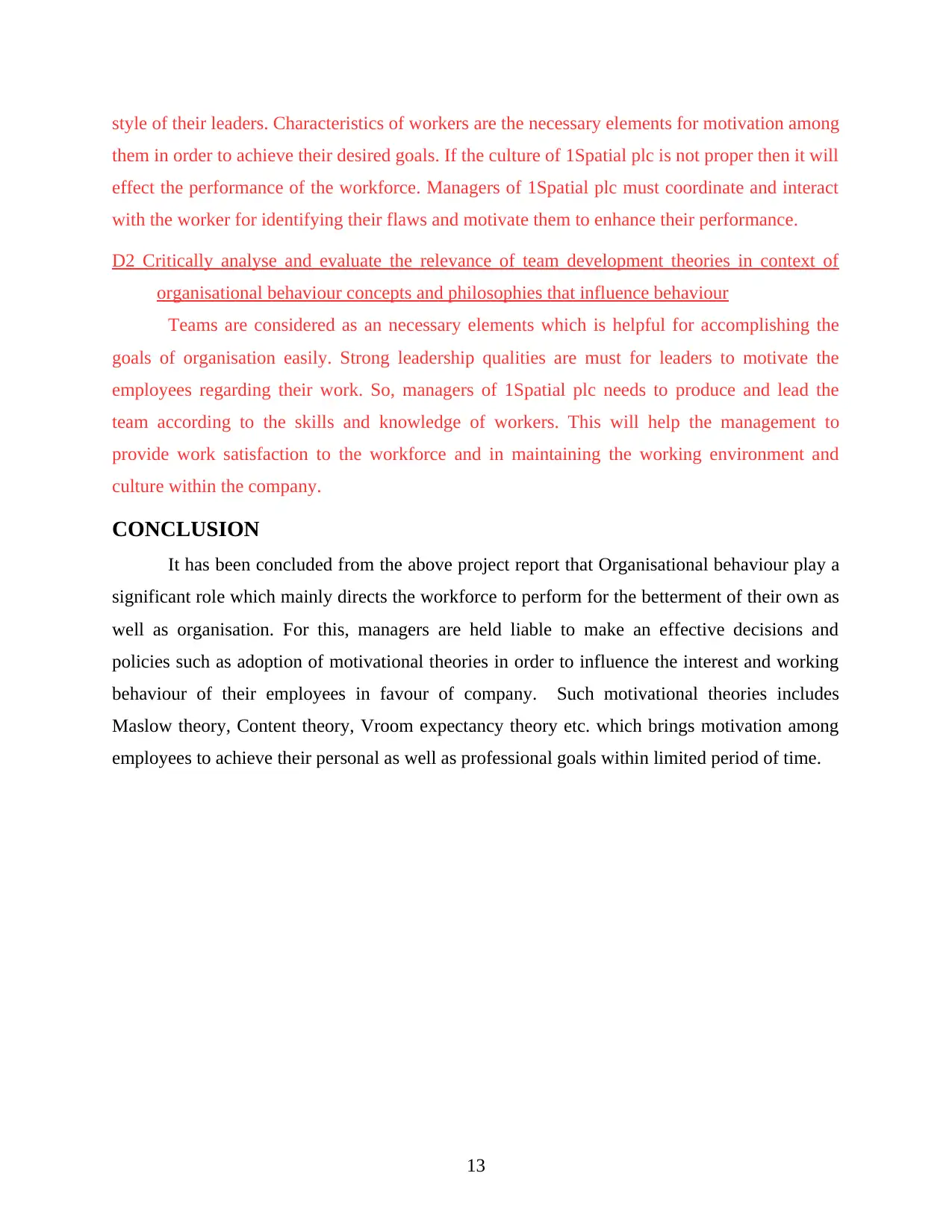
style of their leaders. Characteristics of workers are the necessary elements for motivation among
them in order to achieve their desired goals. If the culture of 1Spatial plc is not proper then it will
effect the performance of the workforce. Managers of 1Spatial plc must coordinate and interact
with the worker for identifying their flaws and motivate them to enhance their performance.
D2 Critically analyse and evaluate the relevance of team development theories in context of
organisational behaviour concepts and philosophies that influence behaviour
Teams are considered as an necessary elements which is helpful for accomplishing the
goals of organisation easily. Strong leadership qualities are must for leaders to motivate the
employees regarding their work. So, managers of 1Spatial plc needs to produce and lead the
team according to the skills and knowledge of workers. This will help the management to
provide work satisfaction to the workforce and in maintaining the working environment and
culture within the company.
CONCLUSION
It has been concluded from the above project report that Organisational behaviour play a
significant role which mainly directs the workforce to perform for the betterment of their own as
well as organisation. For this, managers are held liable to make an effective decisions and
policies such as adoption of motivational theories in order to influence the interest and working
behaviour of their employees in favour of company. Such motivational theories includes
Maslow theory, Content theory, Vroom expectancy theory etc. which brings motivation among
employees to achieve their personal as well as professional goals within limited period of time.
13
them in order to achieve their desired goals. If the culture of 1Spatial plc is not proper then it will
effect the performance of the workforce. Managers of 1Spatial plc must coordinate and interact
with the worker for identifying their flaws and motivate them to enhance their performance.
D2 Critically analyse and evaluate the relevance of team development theories in context of
organisational behaviour concepts and philosophies that influence behaviour
Teams are considered as an necessary elements which is helpful for accomplishing the
goals of organisation easily. Strong leadership qualities are must for leaders to motivate the
employees regarding their work. So, managers of 1Spatial plc needs to produce and lead the
team according to the skills and knowledge of workers. This will help the management to
provide work satisfaction to the workforce and in maintaining the working environment and
culture within the company.
CONCLUSION
It has been concluded from the above project report that Organisational behaviour play a
significant role which mainly directs the workforce to perform for the betterment of their own as
well as organisation. For this, managers are held liable to make an effective decisions and
policies such as adoption of motivational theories in order to influence the interest and working
behaviour of their employees in favour of company. Such motivational theories includes
Maslow theory, Content theory, Vroom expectancy theory etc. which brings motivation among
employees to achieve their personal as well as professional goals within limited period of time.
13
Secure Best Marks with AI Grader
Need help grading? Try our AI Grader for instant feedback on your assignments.
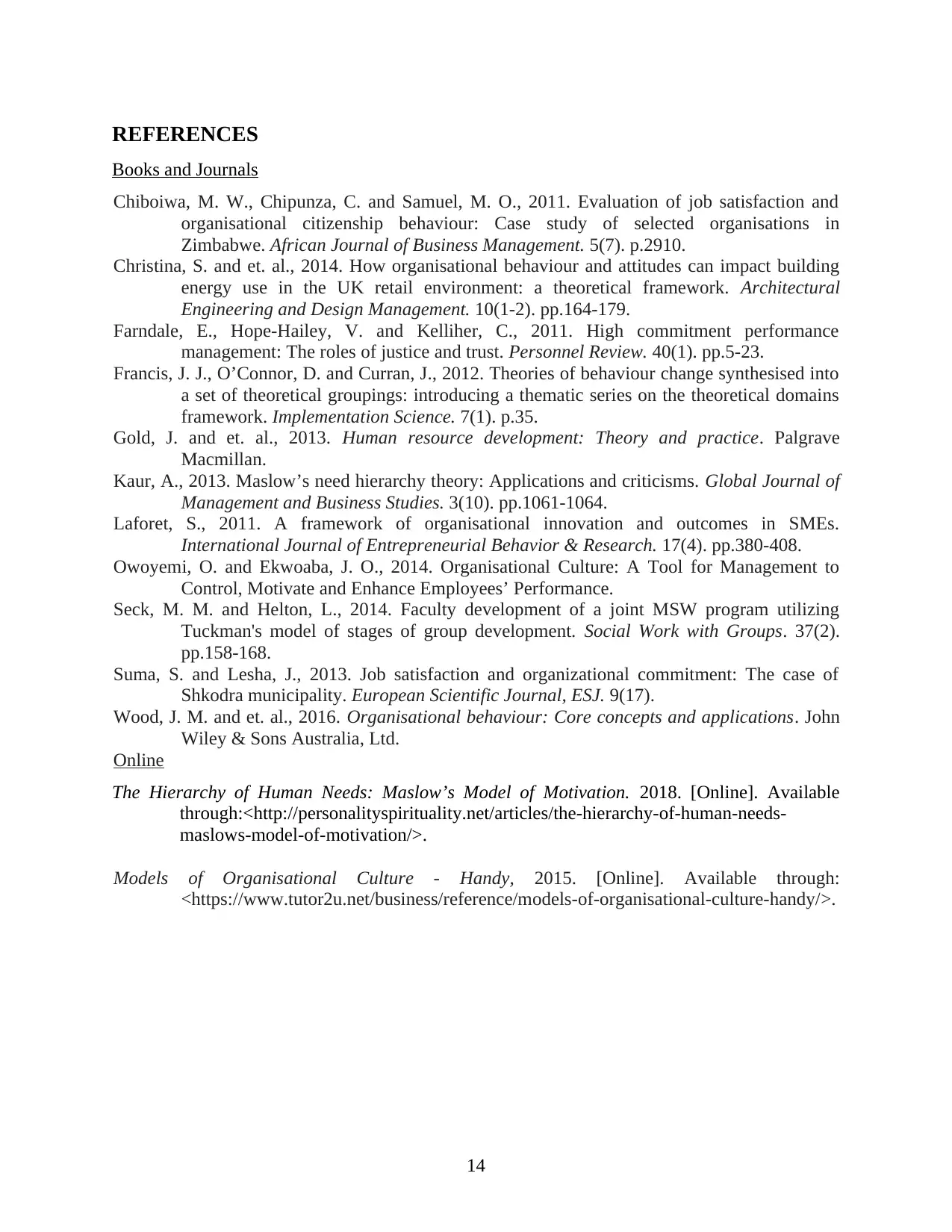
REFERENCES
Books and Journals
Chiboiwa, M. W., Chipunza, C. and Samuel, M. O., 2011. Evaluation of job satisfaction and
organisational citizenship behaviour: Case study of selected organisations in
Zimbabwe. African Journal of Business Management. 5(7). p.2910.
Christina, S. and et. al., 2014. How organisational behaviour and attitudes can impact building
energy use in the UK retail environment: a theoretical framework. Architectural
Engineering and Design Management. 10(1-2). pp.164-179.
Farndale, E., Hope-Hailey, V. and Kelliher, C., 2011. High commitment performance
management: The roles of justice and trust. Personnel Review. 40(1). pp.5-23.
Francis, J. J., O’Connor, D. and Curran, J., 2012. Theories of behaviour change synthesised into
a set of theoretical groupings: introducing a thematic series on the theoretical domains
framework. Implementation Science. 7(1). p.35.
Gold, J. and et. al., 2013. Human resource development: Theory and practice. Palgrave
Macmillan.
Kaur, A., 2013. Maslow’s need hierarchy theory: Applications and criticisms. Global Journal of
Management and Business Studies. 3(10). pp.1061-1064.
Laforet, S., 2011. A framework of organisational innovation and outcomes in SMEs.
International Journal of Entrepreneurial Behavior & Research. 17(4). pp.380-408.
Owoyemi, O. and Ekwoaba, J. O., 2014. Organisational Culture: A Tool for Management to
Control, Motivate and Enhance Employees’ Performance.
Seck, M. M. and Helton, L., 2014. Faculty development of a joint MSW program utilizing
Tuckman's model of stages of group development. Social Work with Groups. 37(2).
pp.158-168.
Suma, S. and Lesha, J., 2013. Job satisfaction and organizational commitment: The case of
Shkodra municipality. European Scientific Journal, ESJ. 9(17).
Wood, J. M. and et. al., 2016. Organisational behaviour: Core concepts and applications. John
Wiley & Sons Australia, Ltd.
Online
The Hierarchy of Human Needs: Maslow’s Model of Motivation. 2018. [Online]. Available
through:<http://personalityspirituality.net/articles/the-hierarchy-of-human-needs-
maslows-model-of-motivation/>.
Models of Organisational Culture - Handy, 2015. [Online]. Available through:
<https://www.tutor2u.net/business/reference/models-of-organisational-culture-handy/>.
14
Books and Journals
Chiboiwa, M. W., Chipunza, C. and Samuel, M. O., 2011. Evaluation of job satisfaction and
organisational citizenship behaviour: Case study of selected organisations in
Zimbabwe. African Journal of Business Management. 5(7). p.2910.
Christina, S. and et. al., 2014. How organisational behaviour and attitudes can impact building
energy use in the UK retail environment: a theoretical framework. Architectural
Engineering and Design Management. 10(1-2). pp.164-179.
Farndale, E., Hope-Hailey, V. and Kelliher, C., 2011. High commitment performance
management: The roles of justice and trust. Personnel Review. 40(1). pp.5-23.
Francis, J. J., O’Connor, D. and Curran, J., 2012. Theories of behaviour change synthesised into
a set of theoretical groupings: introducing a thematic series on the theoretical domains
framework. Implementation Science. 7(1). p.35.
Gold, J. and et. al., 2013. Human resource development: Theory and practice. Palgrave
Macmillan.
Kaur, A., 2013. Maslow’s need hierarchy theory: Applications and criticisms. Global Journal of
Management and Business Studies. 3(10). pp.1061-1064.
Laforet, S., 2011. A framework of organisational innovation and outcomes in SMEs.
International Journal of Entrepreneurial Behavior & Research. 17(4). pp.380-408.
Owoyemi, O. and Ekwoaba, J. O., 2014. Organisational Culture: A Tool for Management to
Control, Motivate and Enhance Employees’ Performance.
Seck, M. M. and Helton, L., 2014. Faculty development of a joint MSW program utilizing
Tuckman's model of stages of group development. Social Work with Groups. 37(2).
pp.158-168.
Suma, S. and Lesha, J., 2013. Job satisfaction and organizational commitment: The case of
Shkodra municipality. European Scientific Journal, ESJ. 9(17).
Wood, J. M. and et. al., 2016. Organisational behaviour: Core concepts and applications. John
Wiley & Sons Australia, Ltd.
Online
The Hierarchy of Human Needs: Maslow’s Model of Motivation. 2018. [Online]. Available
through:<http://personalityspirituality.net/articles/the-hierarchy-of-human-needs-
maslows-model-of-motivation/>.
Models of Organisational Culture - Handy, 2015. [Online]. Available through:
<https://www.tutor2u.net/business/reference/models-of-organisational-culture-handy/>.
14
1 out of 17
Related Documents
Your All-in-One AI-Powered Toolkit for Academic Success.
+13062052269
info@desklib.com
Available 24*7 on WhatsApp / Email
![[object Object]](/_next/static/media/star-bottom.7253800d.svg)
Unlock your academic potential
© 2024 | Zucol Services PVT LTD | All rights reserved.




